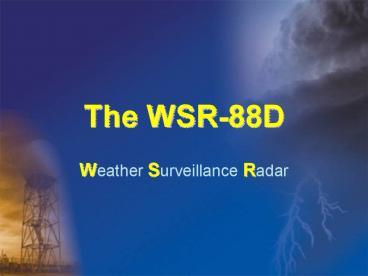The WSR88D - PowerPoint PPT Presentation
1 / 16
Title: The WSR88D
1
The WSR-88D
- Weather Surveillance Radar
2
WSR-88D Components
Steve
AWIPS Advanced Weather Interactive Processing
System
3
Inside the Dome
4
How Does It Work?
- NEXRAD (Next Generation Radar) obtains weather
information based upon returned energy. - The radar emits a burst of energy (green). If the
energy strikes an object (rain, bug, bird, etc),
the energy is scattered in all directions (blue). - A small fraction of that scattered energy is
directed back toward the radar.
5
How Does It Work?
- This reflected signal is then received by the
radar during its listening period. - Computers analyze the strength of the returned
pulse, time it took to travel to the object and
back, and phase shift of the pulse. - This process of emitting a signal, listening for
any returned signal, then emitting the next
signal, takes place very fast, up to around 1300
times each second.
6
Did You Know?
- NEXRAD spends the vast amount of time "listening"
for returning signals it sent. - When the time of all the pulses each hour are
totaled (the time the radar is actually
transmitting), the radar is "on" for about 7
seconds each hour. - The remaining 59 minutes and 53 seconds are spent
listening for any returned signals.
7
What are the different types of radar images?
- Base Reflectivity
- Composite Reflectivity
- Velocity
- Storm Relative Velocity
- One-hour Precipitation
- Storm Total Precipitation
8
Base Reflectivity
9
Comparing Base and Composite Reflectivity
10
Velocity
11
Precipitation
12
Scan Strategies
- Clear Air Mode
- Precipitation Mode
13
Clear Air Mode
- Most sensitive mode of operation
- Slowest antenna rotation rate
- Mostly detects airborne dust and particulate
matter - Occasionally used for detection of light snow
14
Precipitation Mode
- Less sensitive (plenty of returning signals)
- Need to see higher elevation angles (especially
for severe storms) - Helps to analyze the vertical structure of the
storms
15
Coming Soon
- Dual Polarization Doppler Radar
- Sends out a horizontal and a vertical pulse
- Able to identify sizes and shapes of targets
- Also able to detect fall rates, more importantly,
changes in fall rates
16
Contact Info
- john.juskie_at_noaa.gov
- steve.goldstein_at_noaa.gov

















